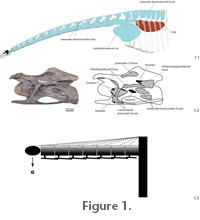|
|
|
INTRODUCTION
Several possible functions of vertebral pneumaticity in sauropods have been proposed, such as weight saving, increased strength of the vertebrae, increased buoyancy of the body, respiration or thermoregulation (Janensch 1947; Coombs 1975; Britt 1993; Wedel et al. 2000). It is evident, that the invasion of pneumatic diverticula into the vertebrae led to a lightening of the axial skeleton (Wedel 2005; Schwarz and Fritsch 2006), which was certainly a prerequisite for the evolution of long necks. The shape of the cervical vertebrae of sauropods strongly suggests that a variety of pneumatic diverticula accumulated around them. In analogy with extant birds, Akersten and Trost (2000, 2001, 2004) assumed that these diverticula might have contributed to a stabilization of sauropod necks. According to this assumption, the system of pneumatic diverticula lying laterally to the vertebral centra provided passive support of the neck beam, making nuchal or other dorsal ligaments obsolete (Akersten and Trost (2000, 2001, 2004). However, strong dorsal ligament systems are well known in birds (Boas 1929; Tsuihiji 2004) and a dorsal ligament system able to brace the neck has also been reliably reconstructed for sauropods (Tsuihiji 2004; Schwarz et al. 2007). Furthermore, the analyses of Akersten and Trost (2000, 2001, 2004) only refer to ventral diverticula, neglecting the dorsal ones – but in birds, the dorsal diverticula in the neck can be nearly as large as the ventral ones, overgrowing the neural spines as big intermuscular diverticula (Müller 1908; O'Connor and Claessens 2005). The pressure regulation and possible ventilation of the cervical pneumatic systems of sauropods and birds have not been discussed in these papers. The concept of pneumatic stabilization in the sauropod neck is intriguing, because it would yield a bracing mechanism in support of the tendinomuscular and bony bracing systems without adding weight and opening the option for the reduction of the dimensions of the non-pneumatic bracing systems. However, it remains speculative whether or not the cervical pneumatic systems were mechanically able to take load and if they could, which anatomical and mechanical configuration of pneumatic systems could have taken maximum load. Therefore, the hypothesis of pneumatic stabilization of sauropod necks was tested experimentally, taking into account the anatomy and topography of pneumatic diverticula reconstructed for sauropods (Wedel et al. 2000; Wedel and Cifelli 2005; Schwarz and Fritsch 2006; Schwarz et al. 2007). Hereby, we did not stress the exact morphology and mechanical properties of an anyway reconstructed sauropod neck construction, but tried to model the basic construction of a pneumatically stabilized segmental beam. This beam consisted of a chain of Styrodur™ blocks. A pneumatic system was modeled with tube-shaped party balloons, tied up with gauze tissue. The basal approach applies to the analogy of a tetrapod neck to a segmented cantilever (Kummer 1959; Alexander 1989; Martin et al. 1998; Hildebrand and Goslow 2001). The objective of the experiment was to investigate the mechanical possibility to stabilize a segmented beam with pneumatic bodies, as well as the effects of different arrangements, fixation and segmentation of pneumatic bodies. The results of the experiment were then applied to different sauropod neck constructions in the frame of the limits of soft-tissue reconstructions for sauropods and with the presumed respiratory apparatus. |
|
